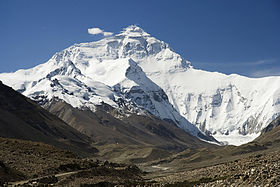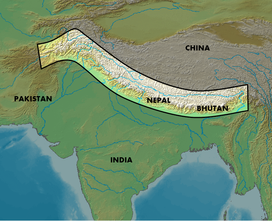
The north face of Mount Everest seen from the path to the base camp in Tibet Autonomous Region, China
The Himalayas, or Himalaya, is a mountain range in South Asia which separates the Indo-Gangetic Plain from the Tibetan Plateau. This range is home to nine of the ten highest peaks on Earth, including the highest, Mount Everest. The Himalayas have profoundly shaped the cultures of South Asia. Many Himalayan peaks are sacred in both Buddhism and Hinduism
The Himalayas are bordered on the north by the Tibetan Plateau, on the south by the Indo-Gangetic Plain, on the northwest by the Karakoram and Hindu Kush ranges, and on the east by the Indian state of Assam, Arunachal Pradesh. The western anchor of the Himalayas — Nanga Parbat — lies just south of the northernmost bend of the Indus River, while the eastern anchor — Namcha Barwa — is situated just west of the great bend of the Yarlung Tsangpo River. The Himalayas span five countries: India, Nepal, Bhutan, China, and Pakistan, with the first three countries having sovereignty over most of the range.
Lifted by the collision of the Indian tectonic plate with the Eurasian Plate,the Himalayan range runs northwest to southeast in a 2,400 kilometres (1,500 mi) long arc. The range varies in width from 400 kilometres (250 mi) in the west to 150 kilometres (93 mi) in the east. Besides the Greater Himalayas, there are several parallel lower ranges. The southernmost of these, located along the northern edge of the Indian plains and reaching about a thousand meters in altitude, are called the Sivalik Hills. Further north is a higher range, reaching two to three thousand meters, known as the Lower Himalayan Range.
Three of the world’s major rivers — the Indus, the Ganges and the Brahmaputra — arise in the Himalayas. While the Indus and the Brahmaputra rise near Mount Kailash in Tibet, the Ganges rises in the Indian state of Uttarakhand. Their combined drainage basin is home to some 600 million people.

